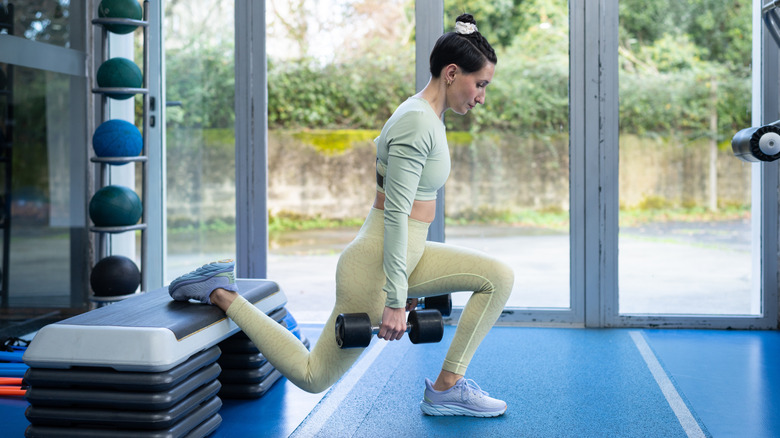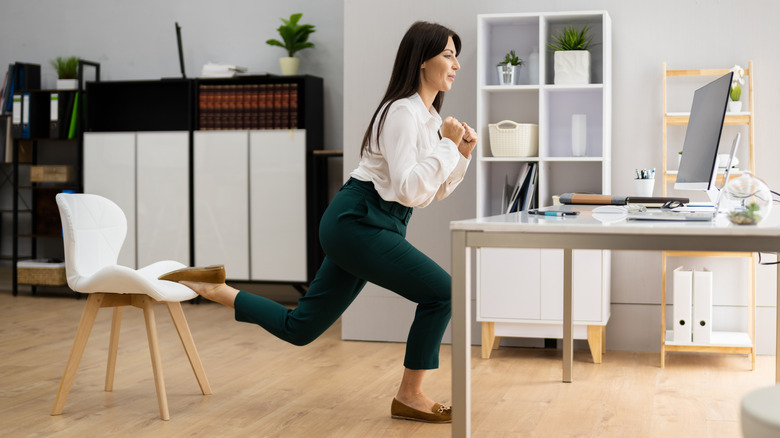When You Do Bulgarian Split Squats Every Day, This Is What Happens To Your Body
When it comes to leg day, you'll often see gym-goers flocking to the leg press or squat rack to build those thick quads and powerful hamstrings. Others might be grinding out Romanian deadlifts to fire up their glutes and hamstrings. Meanwhile, you'll spot plenty of people crowding around the Smith machine or a bench to sculpt their glutes by doing hip thrusts.
But if you want to round out the ultimate leg day, one exercise stands above the rest — the Bulgarian split squat. If you've ever done them, you know why so many people cry "mercy" after just a few reps. This brutal but effective move doesn't just torch your quads. It also strengthens your hips, core, glutes, and hamstrings. Since you're working one leg at a time, you're isolating each side, helping to correct imbalances that could lead to injuries. Plus, those stabilizing muscles that don't always get enough attention in bilateral movements get a serious workout here.
And don't think the Bulgarian split squat is just for people wanting to look good in shorts. This powerhouse move builds strength while reducing strain on your back and knees, making it a go-to for anyone looking to level up their leg game without the extra wear and tear.
The Bulgarian split squat vs. the traditional back squat
A traditional back squat using a barbell or set of dumbbells resting on your shoulders can be a stressful movement if your joints are unstable. If you lack ankle stability, you could feel the weight wobbling forward or backward. You could exacerbate back issues if you lack the core strength to stabilize your torso as you bear the heavy weight. Your knees might also feel strain, especially if one knee is less stable due to a previous injury. (BTW, make sure that you haven't actually been doing squats wrong this entire time.)
A 2021 article in the International Journal of Exercise Science took a closer look at the biomechanics of the traditional back squat compared to the Bulgarian split squat. Although both exercises are mostly associated with leg day, they both are great for strengthening your hips. However, the Bulgarian split squat is a better exercise if you want to reduce knee strain.
Because the Bulgarian split squat is a unilateral exercise (focusing on one leg at a time), it closely mirrors the movements you make in everyday activities and sports. After all, when you walk, run, or perform many athletic movements, you're continually shifting your weight from one leg to another. According to a 2023 article in the International Journal of Human Movement and Sports Sciences, unilateral exercises like the Bulgarian split squat help improve muscle balance, power, and coordination while preventing injury.
How to do a Bulgarian split squat
The Bulgarian split squat might look like a forward lunge, but the key difference lies in the back leg. In a Bulgarian split squat, the back leg is elevated, placing more load on the working leg. You don't need a weight bench to support your back leg. If you're at home, you can use a stable chair, step ladder, or even a couch. Weights aren't necessary, and if this exercise is new to you, it's best to start with just your body weight.
(Here are some other squat variations to try.)
Begin by standing a couple of feet in front of your platform or bench. If you want to target your quads, position yourself about two feet away. To emphasize your glutes, step slightly farther forward. Bend your right knee and rest the top of your right foot on the bench behind you. You may need to adjust your front foot's distance to find a stable stance, depending on your leg length.
Engage your core to maintain stability, then slowly bend your left knee, allowing your left leg muscles to engage. Descend until your left thigh is parallel to the floor, or as deep as your mobility allows. Push through your left foot to return to standing. If your bench is positioned closer, you may need to stop just before your knee moves past your toes.



